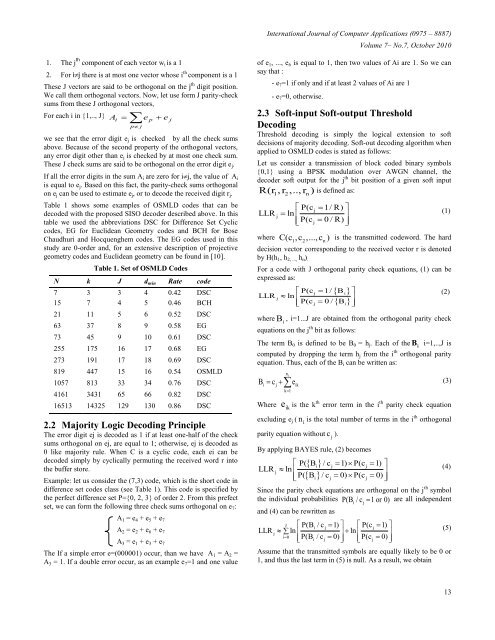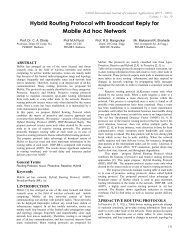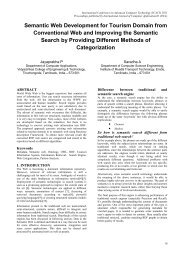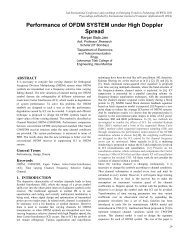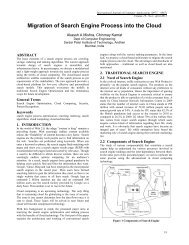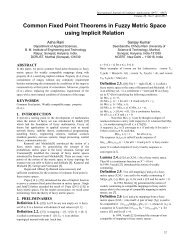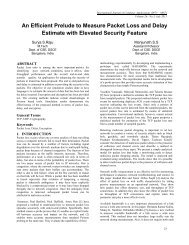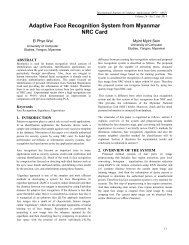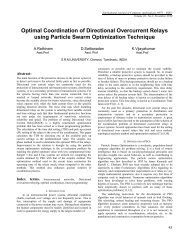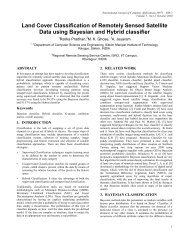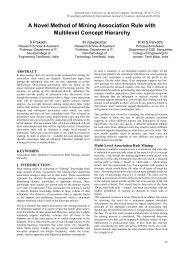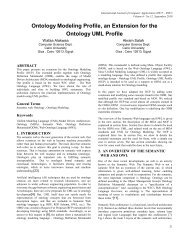IJCA Template - International Journal of Computer Applications - IJCA
IJCA Template - International Journal of Computer Applications - IJCA
IJCA Template - International Journal of Computer Applications - IJCA
You also want an ePaper? Increase the reach of your titles
YUMPU automatically turns print PDFs into web optimized ePapers that Google loves.
<strong>International</strong> <strong>Journal</strong> <strong>of</strong> <strong>Computer</strong> <strong>Applications</strong> (0975 – 8887)<br />
Volume 7– No.7, October 2010<br />
1. The j th component <strong>of</strong> each vector w i is a 1<br />
2. For ij there is at most one vector whose i th component is a 1<br />
These J vectors are said to be orthogonal on the j th digit position.<br />
We call them orthogonal vectors. Now, let use form J parity-check<br />
sums from these J orthogonal vectors,<br />
For each i in {1,.., J}<br />
A<br />
i <br />
p<br />
j<br />
e<br />
p<br />
e<br />
we see that the error digit e j is checked by all the check sums<br />
above. Because <strong>of</strong> the second property <strong>of</strong> the orthogonal vectors,<br />
any error digit other than e j is checked by at most one check sum.<br />
These J check sums are said to be orthogonal on the error digit e j .<br />
If all the error digits in the sum A i are zero for ij, the value <strong>of</strong> A i<br />
is equal to e j . Based on this fact, the parity-check sums orthogonal<br />
on e j can be used to estimate e j , or to decode the received digit r j .<br />
Table 1 shows some examples <strong>of</strong> OSMLD codes that can be<br />
decoded with the proposed SISO decoder described above. In this<br />
table we used the abbreviations DSC for Difference Set Cyclic<br />
codes, EG for Euclidean Geometry codes and BCH for Bose<br />
Chaudhuri and Hocquenghem codes. The EG codes used in this<br />
study are 0-order and, for an extensive description <strong>of</strong> projective<br />
geometry codes and Euclidean geometry can be found in [10].<br />
Table 1. Set <strong>of</strong> OSMLD Codes<br />
N k J d min Rate code<br />
7 3 3 4 0.42 DSC<br />
15 7 4 5 0.46 BCH<br />
21 11 5 6 0.52 DSC<br />
63 37 8 9 0.58 EG<br />
73 45 9 10 0.61 DSC<br />
255 175 16 17 0.68 EG<br />
273 191 17 18 0.69 DSC<br />
819 447 15 16 0.54 OSMLD<br />
1057 813 33 34 0.76 DSC<br />
4161 3431 65 66 0.82 DSC<br />
16513 14325 129 130 0.86 DSC<br />
2.2 Majority Logic Decoding Principle<br />
The error digit ej is decoded as 1 if at least one-half <strong>of</strong> the check<br />
sums orthogonal on ej, are equal to 1; otherwise, ej is decoded as<br />
0 like majority rule. When C is a cyclic code, each ei can be<br />
decoded simply by cyclically permuting the received word r into<br />
the buffer store.<br />
Example: let us consider the (7,3) code, which is the short code in<br />
difference set codes class (see Table 1). This code is specified by<br />
the perfect difference set P={0, 2, 3} <strong>of</strong> order 2. From this prefect<br />
set, we can form the following three check sums orthogonal on e 7 :<br />
A 1 = e 4 + e 5 + e 7<br />
A 2 = e 2 + e 6 + e 7<br />
A 3 = e 1 + e 3 + e 7<br />
The If a simple error e=(000001) occur, than we have A 1 = A 2 =<br />
A 3 = 1. If a double error occur, as an example e 7 =1 and one value<br />
j<br />
<strong>of</strong> e 1 , ..., e 6 is equal to 1, then two values <strong>of</strong> Ai are 1. So we can<br />
say that :<br />
- e 7 =1 if only and if at least 2 values <strong>of</strong> Ai are 1<br />
- e 7 =0, otherwise.<br />
2.3 S<strong>of</strong>t-input S<strong>of</strong>t-output Threshold<br />
Decoding<br />
Threshold decoding is simply the logical extension to s<strong>of</strong>t<br />
decisions <strong>of</strong> majority decoding. S<strong>of</strong>t-out decoding algorithm when<br />
applied to OSMLD codes is stated as follows:<br />
Let us consider a transmission <strong>of</strong> block coded binary symbols<br />
{0,1} using a BPSK modulation over AWGN channel, the<br />
decoder s<strong>of</strong>t output for the j th bit position <strong>of</strong> a given s<strong>of</strong>t input<br />
R(r ,r ,..,r ) is defined as:<br />
1 2 n<br />
P(c 1/ R) <br />
<br />
<br />
<br />
j<br />
LLR<br />
j<br />
ln P(c<br />
j<br />
0 / R)<br />
where C(c<br />
1,c 2,...,c n) is the transmitted codeword. The hard<br />
decision vector corresponding to the received vector r is denoted<br />
by H(h 1 , h 2, ..., h n ) .<br />
For a code with J orthogonal parity check equations, (1) can be<br />
expressed as:<br />
<br />
<br />
j<br />
i<br />
LLR<br />
j<br />
ln P(c<br />
j<br />
0 / B<br />
i<br />
<br />
<br />
P(c<br />
1/ B <br />
<br />
<br />
<br />
where B , i=1...J are obtained from the orthogonal parity check<br />
i<br />
equations on the j th bit as follows:<br />
The term B 0 is defined to be B 0 = h j . Each <strong>of</strong> the B i=1,..,J is<br />
computed by dropping the term h j from the i th orthogonal parity<br />
equation. Thus, each <strong>of</strong> the B i can be written as:<br />
n i<br />
B c e<br />
(3)<br />
i j ik<br />
k1<br />
Where<br />
eik<br />
is the k th error term in the i th parity check equation<br />
excluding e j ( n is the total number <strong>of</strong> terms in the i th orthogonal<br />
parity equation without c ).<br />
i<br />
By applying BAYES rule, (2) becomes<br />
<br />
<br />
<br />
<br />
i j j<br />
LLR<br />
j<br />
ln P( B<br />
i / c<br />
j<br />
0) P(c<br />
j<br />
0)<br />
j<br />
P( B / c 1) P(c 1)<br />
<br />
<br />
<br />
<br />
Since the parity check equations are orthogonal on the j th symbol<br />
the individual probabilities P(B / c 1 or 0) are all independent<br />
and (4) can be rewritten as<br />
J P(B<br />
i<br />
/ c<br />
j<br />
1) P(c<br />
j<br />
1)<br />
<br />
LLR<br />
j<br />
ln ln<br />
<br />
i0<br />
P(B<br />
i<br />
/ c<br />
j<br />
0) P(c<br />
j<br />
0)<br />
<br />
i<br />
Assume that the transmitted symbols are equally likely to be 0 or<br />
1, and thus the last term in (5) is null. As a result, we obtain<br />
j<br />
i<br />
(1)<br />
(2)<br />
(4)<br />
(5)<br />
13


